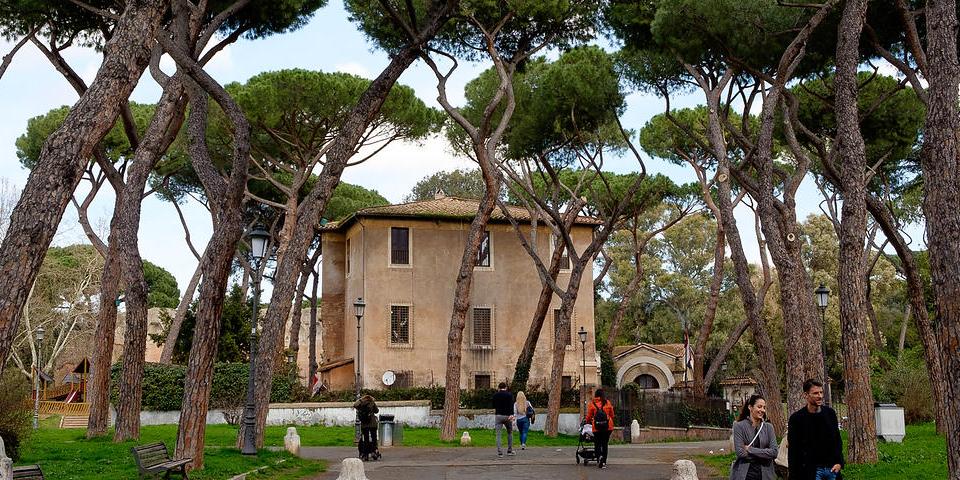

24864 views

| Tip | The hill is not far from the Colosseum, so if you live in Rome's historical center, you can easily reach it on foot. |
|---|---|
| Address | Vle del Monte Oppio, Roma |
Oppian Hill (Colle Oppio) is the southern spur of Esquiline Hill, which lies between the valley of the Colosseum and the valley of Suburra. Despite Oppian Hill being significantly smaller compared to other hills, it houses significant ancient historical artifacts.
Contents
ToggleThere are different versions of the hill’s name origin. Some state that the mountain was named after a Tusculum citizen named Oppius, who helped Romans during Tulus Hostilius’s siege of Veii (an ancient Etruscan city). Others believe that the name derives from the Plebian clan that used to live in this area in Ancient Rome.
Nevertheless, today, Oppian Hill is one of the prestigious Roman districts. Due to the proximity of the major historical sites, most of its apartments have a beautiful city view. The hill’s territory is also famous for its greenery and archeological sites.
Following is the list of places to visit and instructions on how to get to Oppian Hill.
Oppian Hill Park (Parco del Colle Oppio) takes up about 11 ha of Oppian Hill’s territory. The development of Oppian Hill Park started in 1871 when Rome officially became the capital of Italy. However, the park gained its present-day appearance only during the fascist era. Thus, the reconstruction of the public park began in 1928 under the guidance of Raffaele De Vico and was completed by 1936. Oppian Hill Park is decorated with numerous marble statues, fountains, and sculptures. Moreover, due to its proximity to Colosseum, tourists can enjoy an attractive view from the park.
Sometimes called ‘new Pompeii’ of Italy, Domus Aurea (Golden House) today represents an extensive underground palace with more than 300 rooms. The construction of the palace was ordered by emperor Nero after the Great Fire of Rome destroyed his old residence in 64 AD. The scale of Nero’s project was fascinating, as no emperor had planned such an extensive and luxurious palace project before.
According to some estimates, Domus Aurea took up too 50 ha of territory between Palatine and Esquiline hills, meaning that the total area of the palace was 25 times bigger than that of the Colosseum. The territory of the villa also included its private vineyards, forests, and even an artificial lake. The walls of Domus Aurea were encrusted with semi-precious stones and beautiful mosaics.
Probably the most exciting fact is that out of 300 rooms, Domus Aurea did not have any bedroom or kitchen and apparently was used only for the purposes of throwing parties
The remains of the palace were discovered accidentally when a young boy fell through an aperture in Esquiline hill in the 15th century. Later, it turned out to be a cave embellished with ancient mosaics and painted figures. Today, you can visit this extravagant construction only with the virtual reality guided tour that can be booked on the webpage.
After the death of Emperor Nero, subsequent emperors decided to build a platform over the Domus Aurea, which later was used for the construction of other forms of architecture. The construction of the bath of Trajan was, as it is evident from the name, commissioned by the emperor of Trajan in 104 AD. The architect of Bath of Trajan is thought to be Apollodorus of Damascus. The bath complex was aimed to be a recreational and social center for Ancient Roman citizens, both women and men.
Unfortunately, the bath complex quickly became abandoned as late as the early 5th century and was used as a city cemetery. Therefore, only a little has reached our days. However, during 1997 excavation works, archeologists discovered a large, frescoed bird-eye view of a walled port city. Only today, experts are still trying to understand the origins of this frescoed picture.
The Basilica di San Pietro in Vincoli was built in the 5th century and housed famous relics of Saint Peter’s chains (when he was imprisoned in Jerusalem). It is believed that chains were given to Pope Leo I by Empress Eudoxia as a present. Thus, Pope Leo I commissioned the construction of the Basilica to host this sacred relic. The Basilica has quite a simple interior design and decorations; the relic itself is located under the central altar. Visitors are suggested to take a closer look at the frescoes that embellish the walls of the Basilica. You might find some of them depicting skeletons.
Read also What to see in Rome in 3 days
Author: Kate Zusmann
This website uses cookies. For more info read the cookies policy
Rome.us © 2025. Created with love by Roman experts and guides.